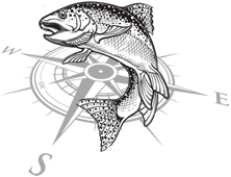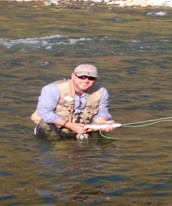
The word prospecting usually denotes someone crawling and climbing all over the mountains looking for gold. We might associate the word miner with that of prospecting where someone is physically working for gold. Even Neil Young is quoted in a song, “I’ve been a miner for a heart of gold.” You might be thinking what does this have to do with fly fishing? Well, like the above mentioned miners we as fly fishers do not prospect for gold or “hearts of gold” however, what we must do is prospect for water holding trout. What I mean is we must search out and find new places where we can find and catch trout on a fly. As more and more folks flood into the interior of the Northwest many of these folks are lured into fly fishing for all the right reasons. Nowhere in the United States is there a faster growing region than the interior Northwest. More and more folks are learning to fly fish and becoming successful fly fishers.
What this means to many fly fishers already living in the interior Northwest is their rivers are becoming more and more crowded or a favorite place you might have never seen anyone fly fishing there before is now a place where you always find folks fly fishing when you arrive. That’s not to say that is a bad thing, they are there for all the same reasons you are there, it’s just you long for the good old days and those secret spots that are secret. You would not divulge these spots to anyone. I can understand how anglers feel about those places. This has led to a real scarcity of knowledge for where to fly fish for the seasoned fly fisher who just happened to move to town or the new fly fisher out to ply their new hobby.
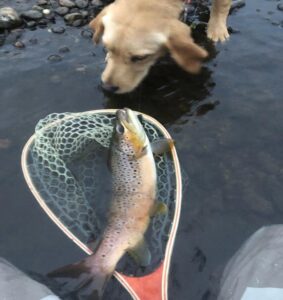
Because of the increase in fly fishing pressure, the spread of secret spots once discovered through social media, and the inevitable broken promise never to tell anyone about your secret spot has caused many fly fishers and fly shops to keep these favorite spots secret. You can find a few of these places through the internet or social media and quite frankly many fly fishers do just that. Then there are those few anglers who don’t mind giving away favorite spots or secret spots for they believe just as I do that none of these places are either sacred or secret. It is easy to learn where all these places are – you just need to do a little work. There is an old saying, “Fly fishers are the laziest people on earth.” I don’t know about that but there may be some merit to the tale. Fly fishers do seem to take the easiest approach to fly fishing, ignoring a more difficult approach to take the easiest.
What does this all have to do with Prospecting for New Water? You never know where all the good fly fishing water is. If you think you do then you live in a world I am not familiar with. I have been fly fishing in the Northwest for most of my life and the last thirty years in particular fishing the waters of Idaho and Montana. My home waters are Southwest Idaho and I’m always prospecting for new rivers and streams to fly fish. I have often been asked how do I know so much about where to fly fish. The answer is easy, I am not a lazy fly fisher nor am I a fly fisher who thinks he has fished all the rivers and streams in my area of the country. In fact I am driven to find new water to fly fish. I spend most of the Winter with my nose in maps and books on particular rivers and streams that might interest me.
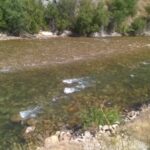
If you are an inquisitive angler like me, looking for new water, your first step is to start researching all the information your can get on water of interest. This begins with a good old fashion map. There are all kinds of maps out there, map books, old school fold up maps, and tourist maps. I prefer the fold up kind you can pick up from the US Forest Service or BLM. However a simple fold up map will work. On these maps you will find blue lines. These blue lines are creeks, streams, and rivers. Do not focus on just one blue line but spend the time to look at every single blue line on the map. Do not just look at them, instead study them. Find their source, find the final destination, follow them with interest. Next, choose one these blue lines that peek your interest. Write them down and begin a list. The next step is to get on the computer and begin with number one on the list. From the computer it should be no surprise to not find anything about your choice. The computer does not know all, it only knows what someone has put in it. However do not be surprised to find some good information on your blue line too. Having exhausted all the information available from your search your next step is to get on Google Maps. Once located on Google Maps, switch to satellite view and see, from a two dimensional point, what the blue line looks like up close from space. Don’t just look at it, study it. Look at how the blue line turns, what canyons are there, how wide or narrow it may be and if there are any blue lines that join it. Sometimes I will study a blue line on Google Maps for over a week before I move on.
From Google Maps I will quickly go to YouTube and see if there are any videos available on YouTube that will show me any visual help on the who, what, where and how information from some angler who may have experienced fishing there. Finally I will exhaust all my fly fishing contacts for any information or experience they may have had on my blue line. When I have exhausted all of the above then I move on to number two on the list and do the same thing until I have researched all the blue lines on my list. The only thing left for me to do is to actually make a trip there to find out for myself when spring arrives. The priority of blue lines on my list is always made by when they can be reached safely and when the runoff will be close to finishing.
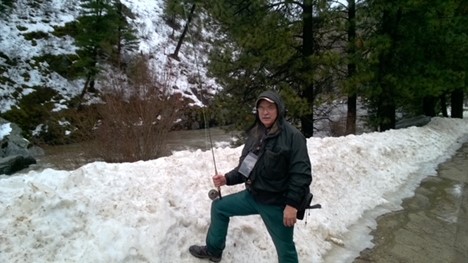
First and foremost on my trip to a mystery river or stream will be to visit the length of the river or stream I have chosen. My first goal is to see if this river or stream will hold trout: fly fishing is secondary. I’m looking first and foremost to see if this water holds trout. When I do find a spot that might hold trout I only spend a small amount of time there, just enough to possibly catch a trout. Whether or not I catch a trout, my stay is short for I have more river to see. Once I’ve determined a body of water holds trout then other things become important such as the quality of camping, any amenities such as lodges, restaurants and gas stations. Spending the day prospecting for trout makes the day fun whether or not you catch trout or not.
If I determine a blue line fits all the requirement for a nice little trout stream or river then I quickly move into fly fishing mode and enjoy the rest of the trip along the river fishing. If it is a no pass, well, I gave it my best shot and there is nothing more to do than to go to the next river or stream on my list. This is prospecting for new water. There are few fly fishers who go through this kind of trouble to find new water to fish. Instead they rely on others to steer them to new places to fly fish. This type of thinking makes the effort to find new fly fishing rivers and streams priceless. You will never find an angler on your new river who has not gone through the same effort of finding your new nugget, and you can bet they will not be passing this information along to just anyone.
As more and more folks move to the interior Northwest for a better life and better fly fishing you can bet the well-known rivers and streams will continue to become known and crowded. However there will always be rivers and streams that are uncrowded and under-fished. You can find them if you just do a little prospecting.

